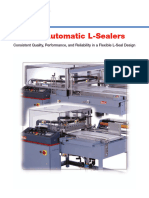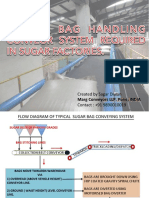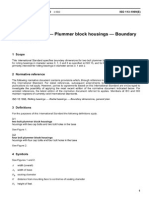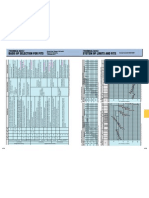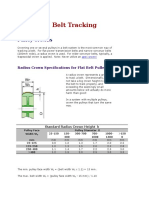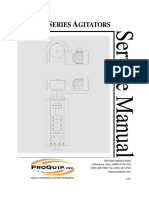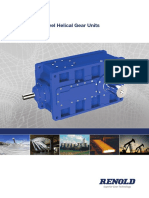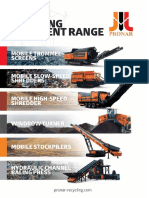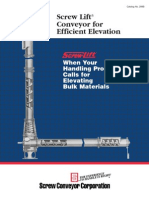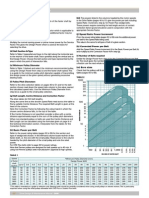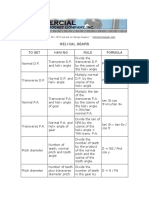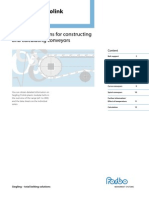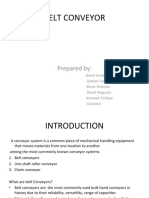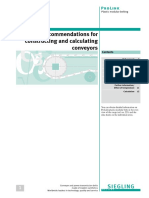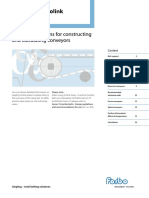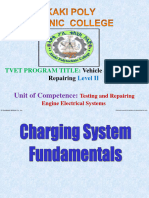0 ratings0% found this document useful (0 votes) 193 views10 pagesModular Design
Copyright
© © All Rights Reserved
We take content rights seriously. If you suspect this is your content,
claim it here.
Available Formats
Download as PDF or read online on Scribd
Design Guide ast
Horizontal Conveyors — Basic Design ieee
Engineering Guidelines,
Edition 104 - 101
Modular Belts typically change their length under
varying operational conditions of temperature and
load. The extra belt lenath is accommodated by
providing en unsupported section of the return way
for catenary sag (calculation of catenary force see
also page 127),
The design of the conveyor frame is dependent on
the total belt length. A screw take-up is used on the
idler shaft for initial adjustment of the catenary sag
only and not for adjustment of the belt tension.
Short conveyors (maximum 2m (6 ft)
In this case belt support on the return side can be
omitted. Screw type take-up (TU) can be necessary
for adjustment of catenary sag. Observe perfect
parallel alignment of shafts
Medium length conveyors (2 to 4 m (6 to 12 ft)
Common design; belt on return way supported by
slider frame (SR) or wear strips. Rollers (R1) can be
used as well. A catenary sag near the driving
sprockets is sufficient for maderate temperature
changes,
Long conveyors (over 4m (12 ft)
Longer lengths and greater temperature changes —
fequite more than one section for catenary sag.
Special concern to vary the roller spacings over long
conveyors,
Admissible speeds of long conveyors:
900-1200 men | 560 rm
(5-48) (545) “Ywo-20)
[up to 15 m (45 fy 50 m/min (750 fin)
15-26 m (45-757) | 30. m/min (90 f/min}
‘over 25m (757) [8 mfmin (45 fvmin)
Gravity take-up
For heavily loaded long belts anc/or high speed the
catenary sags may not sufficiently tension the belt to
prevent sprockets from disengaging. In such cases
the gravity take-up (G) can be an adequate solution,
Recommended tensioner weight:
‘and 0.5 | 15 ko/m (10 ibyft)
belts [30 kgf (20 iby�Design Guide ee |
Horizontal Conveyors — Drive Concepts HabgsiLINKe
Engineering Guidelines
Common head drive -
Slider support on return way, or rollers alternatively
+ Uni-directional drive
One motor (M) at conveyor end, pull action (driving
sprockets are pulling the belt). Catenary sag (CA)
only required on drive end (see also page 127).
+ Bi-directional drive
Two motors (M), one at each conveyor end. Only
‘one motor is pulling, the other motor remains
disengaged (clutch). Catenary sag (CA) at both
conveyor ends.
Bi-directional center drive
Only one motor (M) placed in the middle of the belt
return. This system works well for bi-directional
conveyors. In case of high loads a gravity take-up
may be necessary for positive sprocket engagement. 00 | 1200 mm
Optional solutions: pneumatic or spring loaded (gory ee) |
|
tensioning device.
Since the driving force is applied on the return way of
the belt, the shaft load will be two times the
calculated belt pull
Bi-directional head drive (push/pull action) f
It is possible to apply one head drive motor for
bidirectional reversible driving.
For reverse driving (push action = pusher conveyor}
the belt tension on the return way is 1.2 times
higher than on the carryway. A screw type take-up
{TU) or a pneumatic tensioning device is
recommended. The shaft load will increase to:
Support rollers and backbending diameter
[jBaietye= NN] diameter Tor= = [atametar for oravity take-up] Face ase)
‘support rollers and center drive rollers sliding shoes for elevators _ idling rollers |
RA min.) 2, R3 (min.) | SH (min.) Ulmin)
mm | jneh mm_ | inch mm | inch | mm | inch
Serie M1200 50 2 7% | 3 150 / 2501 1? | 0.72
50 z yoo | 4 150 / 2501 40) 16
“50 | 2 “too | 4 | 180/250" 0 16
100 4 150 | 6 150 / 250° 60 | 24
i004 160 | 6 180/250" [80 | 35
1 As large as possible; with sideguards min. 2 Nosebar transfer. In case an idling roller (U} is
radius 250 mm (109 used in place of sprockets, a minimal diameter,
is necessary.
"Edition Q104- 102�Design Guide
Elevating Conveyors
For the design of elevating conveyors the following
basic rules have to be considered:
M_ The driving shaft must be located at the top
end of the conveyor or in a center-driven design
Slider supports on the transport side with
parallel, serpentine or chevron wearstrips.
Slider supports are preferred. For the majority
of elevating conveyor applications, flights end/or
sideguards are used. In these cases belt edge
slider supports are necessary.
Belt with flights wider 600 mm (24’) have to be
carried in their middle by a slider support strip
(parallel or serpentine). (Fig. below, section x - x).
Catenary sags follow the seme working
Principle as for horizontal belts but are positioned
at the lower end of the belt (see also separate
design recommendations)
The radius of hold down and support shoes
has to be 2 150 mm (6’). The radius should
however be selected at the largest possible.
For belts equipped with sideguards the minimum
shoe radius (back bending radius) has to be
250 mm (701)
Since inclined conveyors are often heavily
loaded, the catenary sag (CA) may not provide
sufficient tension for safe engagement of the
16
>I2 >20"
In cases where |, < 900 mm (35%, or above condi-
tions for the inclination a cannot be maintained, no
catenary sag on the lower end is recommended. In
this case maintain |, > 900 mm (35%) and place the
catenary sag on the upper end.
For all other cases contact the Habasit
Representative.
Standard conception: Catenary sag on lower end
=
HabasitLINK®
Engineering Guidelines
Edition Q104 - 105
Elevators without catenary sag
On Z-conveyors catenary sags may not be accepted,
neither on the upper nor on the lower horizontal belt
section. This may be due to lack of space under the
bottom conveyor end or too short horizontal sections.
A tensioning device with fixed adjustement to the
bett length as shown on the illustration above is not
acceptable, since wear and temperature variations
cause the belt length to change. it must be strongly
recommended to use a selfadjusting tensioner
device. This can be a soft spring type, gasloaded
spring or pneumatic tensioner type.
‘The optimal lay out of the spring or pneumatic
cylinder is depending on the belt type, conveyor
width and temperature conditions. The minimum free
movement of the tensioner must be min. 20% more
than the calculated belt elongation between lowest
and highest process temperature. The force should
be as low as possible, but high enough to overcome
eventual friction forces of the belt on its return way,
‘straigthen it and engage the sprockets safely. As a
general rule the following tensioner force is
proposed:
| for 2" batt '30 kg (20 Io)
{or 1.5" radius belt | 30 kg (20 fb) —
for and 0.5" 15 kg (10 fb)�Design Guide
Radius Belts
Basics
Radius belts create a pressure against the guide in
the inner side of the curve. At the same time they
tend to lift off from the support on the curve outside.
This tendency increases with rising tension,
increasing speed and with increasing angle.
Therefore the design of radius belts require special
attention to the following rules.
R_ The minimum inner curve radius R is defined by
the collapse factor Q of a particular radius belt:
Q depends slightly on the belt width, see table
below; typical values are:
For M2540 and M3840: Q = 2.2 |
For M2543: Q = 1.6
For best running conditions it is advisable to
design the curves R of the conveyor near to the
minimum radius.
lo For proper tensioning of the belt in operation it
needs a catenary sag. For this reason the belt
section lp behind the driving motor must be
straight on a length of preferably 1.5 - bo with a
minimum of 1m (3 ft.). For different require-
ments please contact the Habasit Representative.
|, Aminimum straight section of 2 x belt width
(2 - bo) is required between turns in opposite
directions. No minimum straight length between
curves of the same direction.
lz At the belt end, near the idling shaft, a minimum
straight length of 1.5 - be is required.
Collapse factor
It is typical for the design of radius belts, that the
collapse factor is smaller for very small belt widths be
and increases until it is almost constant above a belt
width of approx 1000 mm (40’). The accurate
collapse factor for Habasit Radius belts can be
calculated as follows:
Quinte and K are typicel values for each belt design.
rection of movement
lo
HabasitLINK®
Engineering Guidelines
Ezition 0104 - 108
+4
241
|
200 | 250 | “300 450 | 500 | 580) 600.) 650 | 700 | 750 | ete.
ei 10,12 iat 20 | 22) 2h) 26 Tete.
03 2.07 | 210 | 212 | 214 | 215 | 216 | 217 | 218 | 218) 220 | ete
1.37 | 1.43 | 1.47 | 1.50 | 1.52 | 1.54 | 1.55 | 1.56.1 1.58 | 159 | 1.59 | 1.60 | etc
1.90 [1.98 [2.03 "2.06 | 2.08 | 2.10 | 2.12 | 2.13 | 2.14 | [215 [2.16 [2.17 | 2.17 | ete. |
ante | 222 2.30 | 236 2.44 | 2.48 | 250 | 263| 255 | 256 | 258| etc.�Design Guide
Radius Belts
Hold down tabs
Radius belts running around curves are radially
pressed against the inner guide rail of the curve.
Since the conveyors usually cannot be built at very
high geometrical accuracy, the belt may tend to flip
over at high loads or engles > 90°. At the inner edge
the belt may move upwards while it is radially
pressed against the guide rail and slip off.
For this reason hold down edge guides must be used
for the in- and outside guide of a curve. If the product
is larger than the belt width or if side transfer over
the belt edge is required, hold down tab modules are
used instead of hold down guides. See also Product
Data Sheets.
Standard application (hold down edge guides)
Ifno side transfer is required, L-shaped hold down
edge guides can be used.
Respect the min. gap between belt and guides. For
sefety reasons (danger of injuries at end of profile) it,
is advisable to apply this profile uninterrupted over
the complete belt length. The material used for edge
guides need to be low friction in contact with the
particular belt material. Generally UHMW PE can be
recommended.
On the return way hold down tabs are needed as
well. An economic solution is shown on the
illustration beside. Also hold down edge guides can
be used as for the top side.
transport side
i t 23
_wearstip (oz
23
belt [min 2-3 rz) |
te di (0.12") ft |
8
return way |
Hold down guides for belt with flights. Belts without
flights follow the same design.
HabasitLINK®
Engineering Gaceines
wes
Belts with hold down tabs (hook modules)
Belts with hold down tabs are used for all
applications where products must be moved
transversally over the belt edge (side transfer). The
use of hold down tabs is also conditional for the
application of sideguards (see also Data Sheet
sideguards in this manual)
Note
The hold down tabs should not be used for radial
guidance or to support (guide) the belt on its return
way. They can be worn away too quickly.
min 2-3, min 2-3
(0.12) (0.12)
transport side
7
mint.5 =
(0.08!) wearstrip
min23 00 min 2-3
Lotz) min 2-3 _(0.12')
High speed applications
For speeds > 40 m/min it is recommended to use
prelubricated materials for radius guides. To keep
the temperature low, prefer guide material with best
possible heat conduction properties (eg. PA
prelubricated).
For further information and other dimensions see
Design Guide Slider Support Systems.�Design Guide
Sprocket Evaluation HabeceNk®
Engineering Guidelines
Edition Q104 - 109,
Dimensional requirements for installation -
‘C= belt pitch si slider support
Number Polygon | Pitch dp | Art mm ‘Ao #1 mm (effective)
oftesth effect (effective) Standard Special belt types
thickness
mm inch | mm inch | mm inch mm inch mm inch mm inch | mm inch
10 161 063 | 261 1.03 t
1 2671.05 | 36.7 1.44 ~ 7
28 4511.78 | 551 217 I
28 538 212 | 638257 i
36 704-277 | 804 3.17
a 247 097 | 347 137 | 357 141/372 1.46) 98.7 1.52 | 40.7 1.60
8 112 181 393 1.55 408 1.61/42.3 167) 44.3 1.75
0 143 | 463 182 | 473 1.86/488 192/603 1.98 623 206
2 (448 1.74 | 543 214 ($532.18 568 224/683 2.50 60.3 2.97
18 60.4 298 | 704 277 9 287| 744 295) 764 3.00)
78 684269 | 784 3.09 | 809 5.19) 824 3.24 | 844 2.32
20 785 3.01 | 865 3.41 89.0 3.50) 90.5 3.56 | 92.5 2.64
[247097 | 35.7 141 374 147
2342 | 383 1.55 (413 163/410 162
"983 143| 47.31.86 [49.3 1.94/490 1.93
853 218 |873.226|570 224
60.4 2.38 | 70.4 2.77 [73.42.89 71.4 281
84269 | 734 379 |#14920/811 319;
765 9.01 | €75 344 | 095 2.52|092 351
e 4201.65 | 60.0 2.36 | 630 2.48)
12 “6602.60 337 [870 3.48
16 901385 | 108.1 4.26 (11.14.37
134% | 1021-40 | 439 1,70 | 500 292 |60.2 257
| 747 2.94 | 759 2.99)
—[oa3% 308367 [318.361
34% [197278 | 908 9.57 1066 420 1078424
19% | 2615 109 | 122.7 4a9 | 1987 6.46 199.9 557
671 264,
827 326)
[986 388
42.2 6.60 1468 6.78�Design Guide
Sprocket Evaluation
Design recommendations
‘The correct adjustment of the belt support or shaft
placement (Dimension A1} is important. Excessive
noise, increased sprocket wear and engagement
problems may result if the recommendations are not
followed.
Standard solution Gu benpich
Straight support guides are low cost and simple to. | a
produce, |
The distance C between belt support and wear strip |
allows the respective link row to adapt its position to f
‘the up and down moving sprocket circumference
{polygon effect). Take care that guides do not touch
‘the sprockets.
Optional
For smoother belt run and best load support and
‘transmission at belt end it is recommended to bend
the weer strips as shown. Take care that guides do
not touch the sprockets.
9
HabasitLINK®
Engineering Guidelines
Edition Q104- 110
slider suppor
Ay
1
Ao)�Design Guide
Sprocket Evaluation
Sprocket installation, general oo
{see also Product Data Sheets}
fon
HabasitLINK®
Engineering Guidelines
Edition Q104 - 111
In order to allow the belt to expand/contract, only the IT rt
center sprocket on each shaft is fixed. For shafts
with 2 sprockets, the sprocket on the drive side is
fixed. Various locking methods are possible: | en
* Set screws and set collars _ _|
Mainly used with round shafts on key-ways Type: Set screws and set collars
Retainer rings
For square shafts (no key-ways needed}
+ Retaining plate
There should be @ gap of 0.3 mm (0.07') between
simple low cost method for square shafts | I ; ©
sprocket hub and retaining device. All devices must
be securely fastened,
|
retainer ring (circlip)
Type: Retainer rings
plate
Type: Retaining plate
Tracking of M5010, M5011, M5013, M5014 : taining ok
The molded standard sprockets are tracking the belt, Welainina pints
leaving some transversal clearance to the belt (approx. \
+ 2.5 mm (0.107). This is of advantage in food
sprocket
applications with very critical cleaning requirements,
eg. in the meat industry. For other applications it
might be desirable to reduce this clearance in order to
provide accurate tracking performance. The most
‘common way to do this is to use a pair of center | sistance ol sp
sprockets instead of one only. These two sprockets
are both located on the shaft in a fixed distance by
‘one center fixing plate of 20 mm (0.791) width
Top-side drive for Spirals
In exceptional cases spiral applications may require to
drive the belt by engaging the sprockets from the top
side of the belt instead of the bottom side. In this
case specially adapted sprockets are needed. Such
sprockets are available for M2540 and M2543, but
not for M3840. For specific information please take
contact with Habasit.
20-4- 1mm
rocket hubs

